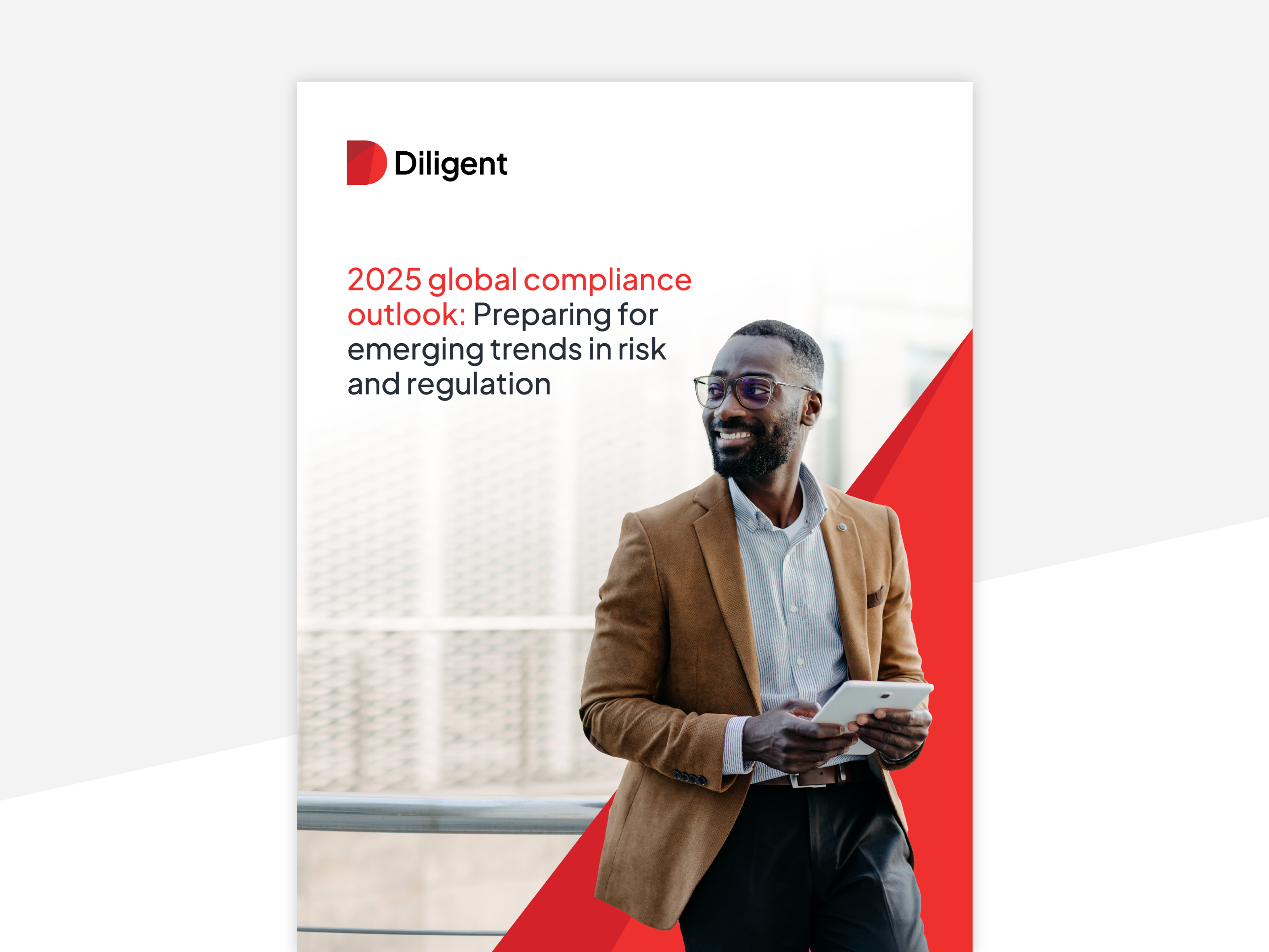9 strategic risk examples and how to successfully tackle them

What is meant by strategic risk? Strategic risk examples encompass many different risks — and depending on the nature of your business, you may face any or all of them. Understanding the types of strategic risk you face is fundamental to your ability to tackle them as part of your broader governance, risk and compliance (GRC) strategy.
Whether you are a chief risk officer and strategic risk falls firmly within your orbit, or whether as CFO, CEO or general counsel, you take more holistic responsibility for your organization's risk strategy. Understanding and mitigating risk at a strategic level will be a priority.
In today's hyper-connected world, the risk evolves faster than businesses can devise strategies to tackle it. Being familiar with different strategic risk examples can help you get ahead of the curve, helping you identify the types of strategic risk your organization faces and the tactics you can put in place to respond.
Understanding the different types of strategic risk
'Strategic risk' is a term that's often bandied about. But what does the phrase mean in practice? What types of risk are defined as 'strategic?' How do you identify strategic risks? What are the examples of strategic risks you might face in your organization? What are the types of strategic risk you should prioritize in your risk mitigation strategy?
What is strategic risk?
Strategic risk is a category of risk; alongside operational, financial, regulatory and other business risks, it forms part of the umbrella of risks your organization faces.
When we look at strategic risk examples, they are generally defined as those that threaten a business's ability to set and implement its chosen strategy.
They may be external; events like the Covid-19 pandemic are the perfect example here.
They may be 'self-inflicted,' brought about via an organization's own strategy and decision-making. An example of this would be the accelerating digital transformation of businesses, which has delivered many positives but has also exposed new types of risk.
Exploring strategic risk examples
Regulatory and legislative drivers relating to governance, risk and compliance strategies more generally are also prompting businesses to focus on strategic risk. At the same time, a spotlight has been thrown on strategic risk via growing awareness of the close ties between risk, compliance and business value.
This evolution of risk has led organizations to try and bring some structure to their mitigation strategies by categorizing and prioritizing the risks they face. Let's look at some of the examples of strategic risks you might face.
Some sources distill strategic risks into five types, sometimes called the 'five sources of strategic risk.' However, look up several different sources, and you will find a variety of risks listed among the 'five types.'
Our list of strategic risk examples below includes more than the standard five.
What are the 9 examples of strategic risk?
Among the types of strategic risk you should have on your radar are:
1. Competitive risk: The risk is that you fall behind your competitors as they innovate and improve their offerings faster than you.
2. Change risk: The digital transformation risk we cited above is a prime example of this ' the inherent risks of introducing any change program.
3. Regulatory risk: Regulatory risk is any new regulation has the potential to:
- Disrupt your business
- Create new responsibilities
- Demand new technologies (and therefore linking back to change risk)
- Distract your business leaders from their operations as their time is abstracted to put in place new governance processes and control measures
Learn more about today's most pressing regulatory risks by downloading the latest edition of our global compliance outlook.
4. Reputational risk: The risk that your corporate standing is threatened. The potential causes of this are legion, from regulatory compliance breaches to shareholder activism or poor performance in public ratings, such as those used to measure ESG performance.
5. Political risk: The potential for political change, or the political landscape overall, to disrupt your business. For example, through volatility in a country within your supply chain.
6. Governance risk: The risk brought about by poor governance, risk and compliance processes within your organization.
7. Financial risk: Risks relating to the financial health of the organization. This differs from...
8. Economic risk: This refers to the broader economic landscape and its potential to affect the success of your business strategy.
9. Operational risk: The risk is that your operations and business processes are not up to standard.
Many of these examples of strategic risk are inter-connected. For instance, if you face operational risks around the efficacy and rigor of your processes, this is likely to expose you to financial or regulatory risk. Similarly, if you fail to tackle governance risks, you may well encounter reputational risk.
The intertwined nature of the types of strategic risk emphasizes how important it is to take an integrated approach to address them.
How to tackle the different types of strategic risk
Amongst all these strategic risk examples, there are positives. The linkages that cause one risk to increase the chances of another can also work to your advantage. Take a coordinated, integrated stance on one aspect of strategic risk, and your performance in others should also improve. As companies refine their approaches to risk mitigation, they become better able to recognize these connections. As a result, they can approach risk strategically, capitalizing on synergies for a more robust result.
Below we also set out some specific tips that can help you tackle the different strategic risk examples:
1. Competitive risk: Remaining competitive means understanding your competition; data is key here, and technology can be your friend in enabling you to provide your board with the competitive intelligence they need.
2. Change risk: Here, good governance is the secret. Put governance at the heart of your change programs and reduce the risks they bring while enhancing their benefits.
3. Regulatory risk: Keeping on top of the latest developments in the fast-moving regulatory landscape is vital here — you can't meet expectations if you're not aware of them. Ensure you keep abreast of the news and trends in risk and compliance.
4. Reputational risk: Bolster your GRC processes, and you have a better chance of swerving the risks that can derail your brand.
5. Political risk: There is less you can do here, although ensuring you build sustainable supply chains rooted in countries where political volatility is less of a threat can help make your operations more resilient.
6. Governance risk: As with change risk, robust governance processes and controls are essential to reducing risk here.
7. Financial risk: While some financial risks come from external factors, improving your ability to measure, monitor and respond to the business risks you face, if done successfully, should minimize the financial threats that fall within your wheelhouse.
8. Economic risk: Sustainable supply chains can help here, reducing the threat from economic instability in countries you source from. And, again, keeping pace with external events that can affect your risk profile is vital.
9. Operational risk: One of the areas you have the most control over, introducing agility, rigor and structure to your operations can significantly reduce your risk across all areas of your organization.
Understand and respond to all types of strategic risk
Hopefully, this article has given you a deeper understanding of the types of strategic risk you face, some examples of strategic risk that bring this to life. It has also provided insights into how you can tackle different strategic risks.
Remaining on the front foot in terms of upcoming legislation, economic trends and governance best practice can really make the difference — amplifying your ability to be leverage strategic and proactive in the face of changing risks.
The Cyber Leadership Playbook
Few risks have evolved as rapidly — or as unpredictably — as cyber risk. Yet, despite growing awareness, many organizations still struggle to bridge the gap between cybersecurity, legal oversight and executive decision-making.
The Cyber Leadership Playbook is designed to help Chief Information Security Officers (CISOs), General Counsels (GCs) and board members work together to build a stronger, more strategic approach to cyber resilience.
Keep exploring

Cybersecurity governance and the CISO's dilemma
In this episode, Jim Alkove, co-founder and CEO of cybersecurity company Oleria, shares insights for CISOs.

2025 global compliance outlook
Download our 2025 global compliance outlook to confidently navigate complex regulations, enhance risk management and secure your company's future.

11 best practices for effective ERM reporting
Turn potential risks into business opportunities. Discover our 11 best practices for enterprise risk management (ERM) reporting.